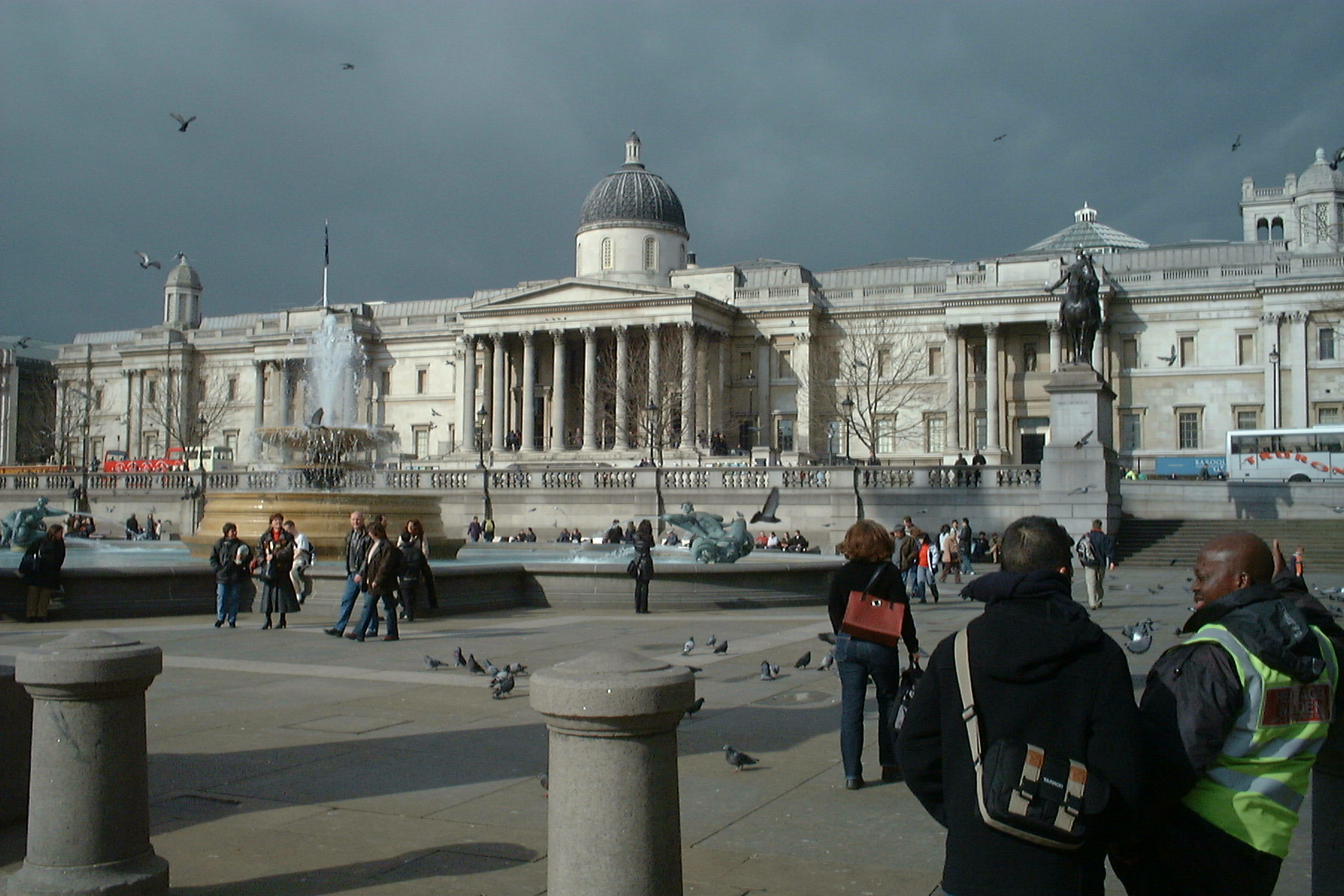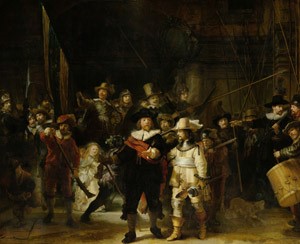リスク対応策 2020.02.18
RM 13 「レンブラント」の示唆 Implications of “Rembrandt”
目次
Copyright © Shinichiro Hatani 2020 All rights reserved
For those who prefer to read this column in English, the Japanese text is followed by a British English translation, so please scroll down to the bottom of the Japanese text.
「国立美術館」の英文名「ナショナル・ギャラリー」、この名を冠する美術館は、世界中に数多くある。しかし単に「ナショナル・ギャラリー」と呼ぶ場合、多くの人の頭をよぎる美術館は、おそらく1つしかないだろう。仏ナポレオン軍をトラファルガーの海戦で破り、英国に勝利をもたらした英雄ネルソン提督。彼を記念して造られたロンドン「トラファルガー広場」、その正面にある世界最大の美術館の1つ、「ナショナル・ギャラリー」であろう。
損害保険会社の経営コンサルタント時代は、ロイズ(Lloyd’s of London)のアンダーライター達と商品開発のため、グローバル・リンクを開業してからは、キャプティブからの再保険手配に関して、またキャプティブのメリットを最大限活かす仕組みの更なる調査のため、ロンドンに頻繁に出張してきた。
これまでロンドンに出張した回数は、自分では記録していなかったのでどれくらいになるかと、航空会社のマイレッジプログラムのサイトを見てみたら、定期的にロンドン出張を開始した1999年12月からこの20年あまりで、合計83回とあった。その度に、疲れた頭を癒すため世界の至宝ともいうべき美術品の数々と対話をしてきた場所がナショナル・ギャラリーである。
この3月3日から「国立西洋美術館」で、「世界屈指の美の殿堂 ロンドン・ナショナル・ギャラリー、世界初の大規模所蔵品展」が開催される。「世界初開催!全61作品日本初公開」とある特設ホームページには、ナショナル・ギャラリーのことを次のように記してある。
ロンドン中心部、トラファルガー広場に面して建つ世界屈指の美の殿堂、ロンドン・ナショナル・ギャラリー。多くのヨーロッパの美術館とは違い王室の収集を母体とせず、1824年に国家制定法によって、市民の力で市民のために設立されました。同館は英国を含む幅広い地域と時代のヨーロッパ絵画を網羅し、13世紀後半から20世紀初頭までの約2,300点の作品を所蔵し、年間の来場者数は世界の美術館・博物館でもトップ10に入る約600万人超を誇ります。

1.レンブラント
「大英帝国」と呼ばれた時代、巨大な軍事力と資金力により、世界中から集められた品々が展示されている「大英博物館」から、1824年分離独立して設立された美術館がナショナル・ギャラリーである。そこに、その画家の絵がある。
館内にある数多くの絵は展示場所を移動されているが、その絵は、この20年間1度も動かされてない。終日、人だかりが絶えない「北棟(ノース・ウィング)」の第23展示室にある。冒頭記した「国立西洋美術館のナショナル・ギャラリー」展にやってくる真正面の若き「34歳の自画像」と対比展示されている、17世紀を代表するオランダの画家、レンブラント・ファン・レイン、光と影の画家「レンブラント」、その人の「63歳の自画像」である。目はあくまでも澄み、穏やかな表情、見る人を画面に引き込まずにはいられない、素晴らしい作品である。
しかし、その作品を描き上げた当時の彼は、不遇と失意の最終章にあった。1606年オランダのライデンに生まれたレンブラントは、創作活動の初期から、その名が、当時世界最大の国際都市アムステルダムにまで聞こえるほど、高い評価を得ていた。
2.夜警
しかし、彼の転機は、その頂点、1639年アムステルダム市内に大邸宅(現「レンブラント・ハウス美術館」)を購入、世界的に有名な「夜警」を1642年に描き上げ、家庭的にも経済的にも恵まれ大成功を収めていた時に訪れた。
その絵は、アムステルダム「国立ミュージアム(美術館)」ホール正面に入ると、真っ正面の一番奥に見える。その「オランダの至宝」として展示されている「夜警」をめぐり、彼の芸術性と注文主の意図がかみ合わず訴訟を起こされたのである。
この影響で、収入の大半を占めていた富裕層からの肖像画の注文が激減した。さらに、オランダは第一次英蘭戦争に敗れ、海上貿易の主導権を英国に握られるようになり国際的な地位が低下して未曾有の不況が訪れていた。そのため、絵の注文が全く絶え、結果、自己破産することになった。
モデルを雇う資金もなくなった彼は、その後ひたすら自らを描き続け、人生においても「光と影」を極め、その生涯を終えたのである。

3.頂点(天)に潜むリスク
同様のことは企業経営においても起きるものである。「『有頂天』(元々は、仏教用語で「世俗に歓喜し忘我の極み」)になる」という言葉があるとおり、往々にして「頂点」を極めているときに失敗の原因は創られる、「リスクをリスクとして認識できない状態」になっている可能性が高いからである。
監査役にコンプライアンス(法令順守)・オフィサーとしての役割を強く求め、また社外取締役制度の導入、さらには委員会等設置会社に移行すること等が求められてきた。しかし、「企業経営リスク」は「コンプライアンス」の視点のみならず、ステーク・ホルダー(利害関係者)に対する効率的経営の責務を果たす、「コーポレート・ガバナンス(企業統治)」の側面からも検証しなければならない。
4.リスクの住処(すみか)
この「取締役・監査役」は、経営資源の配分を決める、つまりは「ヒト、モノ、カネ」をどの分野に投与するか否か大局的に判断する「機関」であり、「個別具体的な業務執行」、つまり「リスク」が存在する大半の業務には直接関わってはいない。さらに、「リスク」は、何も役員レベルの判断を仰ぐ部分にのみ存在するものでもなければ、またその判断の重要性に比例してリスクの大きさが決まるものでもない。
昨今、後を絶たない「法令違反行為」や「個人情報の流出」等、企業経営に大きなリスクとなるものは、むしろ「役員会の決議」を受けるような「重大事項」ではなく、その必要のない「部課長級の管掌・決裁事項」とされてきたものが実はその大半なのである。
欧米では、この「個別具体的な業務執行」に潜むリスクに対応するため、多くの企業で「リスクマネージャー」をCOO(チーフ・オペレーティング・オフィサー:最高業務執行責任者)と同格のCRO(チーフ・リスク・オフィサー)として処遇。その部下、数人から数十人を介して、全社の隅々まで張りめぐらした「リスクマネジメント網」を通して、社内各部門のリスク分析、対応を恒常的かつ専門的におこない、必要に応じて、「執行役会議(経営会議)」、「取締役会」等に意見具申、タイムリーにリスクマネジメントをおこなうようになったのである。
そのため「監査役」等の機能強化のみを目指すのではなく、その機能はあくまでも「縦軸」と捉え、社内各部門のリスクを分析、対応するため「リスクマネジメント組織」を設立。これを「横軸」として「統合的なマトリクス」を構築、全社的な「リスクマネジメント体制」を確立しているのである。日本企業においても是非取り入れるべき「経営課題」ではないだろうか。
本格的なリスクマネジメントをおこなって、その結果としてキャプティブを設立した場合、キャプティブ・コンサルタントとともに、そのメリットを最大限活かす主役は、その組織のトップであるリスクマネージャーの職務となるからである。
今回のまとめ
企業が事業の遂行にあたり用心すべき時期は「過去最高の売上、過去最高益の時」と言っても過言ではないだろう。これまでの歴史がそれを証明しているからである。
その時、リスクマネジメントが働き不測の事態を招かないように、リスクマネジメント組織、人材の整備には早め早めの対応が必要である。メディアで一時期流行った言葉、「何時やるのか、それは『今』でしょう」と申し上げておきたい、後悔しないように。
執筆・翻訳者:羽谷 信一郎
English Translation
Risk Management 13 – Implications of “Rembrandt”
The National Gallery, the English name for a national museum, is one of the many museums in the world that bear this name. But if one were to simply call it the National Gallery, there is probably only one that comes to mind, and that is the National Gallery.
Admiral Nelson was a hero who defeated Napoleon’s army at the Battle of Trafalgar and brought victory to Britain. The National Gallery, one of the largest museums in the world, is located in front of London’s Trafalgar Square, which was built to commemorate him.
During the years as a management consultant for a general insurance company, I travelled frequently to London to work with Lloyd’s of London underwriters on product development and, since opening Global Link, to arrange reinsurance from captives and to further investigate how to maximize the benefits of captives.
I looked at the airline’s mileage program website to see how many times I had traveled to London, as I hadn’t kept track of the number of times I had done so, and found a total of 83 trips to London in the last 20 years or so, since December 1999, when I started traveling regularly. Each time, I have visited the National Gallery to relax my weary head by talking with some of the world’s most treasured works of art.
From March 3, the National Gallery of Western Art will present the world’s first major exhibition of works from the collection of the National Gallery of Art, London, one of the world’s great temples of beauty. A world first! On its special website, the National Gallery of Art is described as follows
The National Gallery of London, one of the world’s leading art museums, is located in the heart of London, facing Trafalgar Square. Unlike many European museums, it is not based on a royal collection, but was established by a national statute in 1824 by the people, for the people. The National Gallery’s collection covers a wide range of European paintings from the UK and other regions and eras, and contains some 2,300 works of art from the late 13th to the early 20th century, making it one of the top ten museums in the world with over 6 million visitors per year.
1. Rembrandt
The National Gallery was established in 1824 as an independent museum from the British Museum, which exhibited objects collected from all over the world during the period known as the British Empire, thanks to its enormous military and financial resources, and this is where the artist’s paintings are located.
Many of the paintings in the museum have been moved from one place to another, but the paintings have not been moved even once in the last 20 years. It is located in Gallery 23 of the North Wing, where crowds of people have been gathering all day long. It is a 63-year-old self-portrait of Rembrandt van Rijn, the painter of light and shadow, and Rembrandt, the Dutch painter of the 17th century, who is right in front of the young “Self-Portrait of 34 Years Old”. It is a wonderful work of art, with clear eyes and a serene expression that cannot help but draw the viewer into the picture.
But at the time of his painting, he was in the final chapter of unhappiness and disappointment: born in Leiden, Holland, in 1606, Rembrandt was so highly regarded from the beginning of his creative career that his name could be heard in Amsterdam, the largest international city in the world at the time.
2. The Night Watch
But the turning point in his career came in 1639, when he bought a large house in Amsterdam (now the Rembrandt House Museum) and painted his world-famous “The Night Watch” in 1642, while he was enjoying great family and financial success.
The painting can be seen at the far end of the hall of the “National Museum” in Amsterdam, directly in front of you. He was sued over The Night Watch, the “Dutch treasure”, when his artistry and the intentions of his client did not mesh.
This led to a sharp decline in orders for portraits from the wealthy, who made up the bulk of his income. Furthermore, the Netherlands had lost the first Anglo-Dutch War and was in the midst of an unprecedented depression as its international standing declined as Britain took control of its maritime trade. As a result, orders for his paintings dried up and he was forced to go bankrupt as a result.
With no more money to hire models, he devoted himself to painting and ended his life in “light and shadow”.
3. The risk of being at the top (“Uchoten” in Japanese heaven)
The same thing can happen in the management of a company. This is because, as the saying goes, the cause of failure is often created when a company has reached the “Uchoten”(pinnacle,originally, it was the Buddhist term for the ultimate in worldly delight and forgetfulness) of its achievement, and there is a high probability that the company has reached a point where it is unable to recognize risk as a risk.
There have been calls for corporate auditors to play a stronger role as compliance officers, to introduce an outside director system, and to transition to a company with committees. However, “corporate management risk” must be examined not only from the perspective of compliance, but also from the perspective of corporate governance, which fulfills the responsibility of efficient management to stakeholders.
4. The Home of Risk
These directors and auditors are the organizations that decide on the allocation of management resources, or in other words, they are the ones that make the big picture decisions about which fields to allocate “people, goods, and money. In other words, they are not directly involved in the majority of operations where there is “discrete and specific execution”, or “risk”. Furthermore, “risk” is not something that exists only at the executive level, nor is the magnitude of risk proportional to the importance of that decision.
In fact, most of the major risks to corporate management, such as the incessant violation of laws and regulations and the leaking of personal information, are not serious matters that require a board resolution, but rather matters that are not necessary and are considered to be matters under the control and approval of department and division managers.
In Europe and the United States, many companies treat risk managers as chief risk officers (CROs), the same rank as chief operating officers (COOs), in order to deal with the risks inherent in the execution of individual, specific operations. Through the “risk management network” that extends to every corner of the company, this person constantly and expertly analyzes and responds to risks in every department of the company through their subordinates, from a few to several dozen people, and when necessary, submits their opinions to the Executive Committee (management committee), the Board of Directors, etc., to ensure that risk management is carried out in a timely manner.
To this end, the company has established a risk management organization to analyze and respond to the risks of each department in the company, rather than just strengthening the functions of auditors. With this as the horizontal axis, they have built an integrated matrix and established a company-wide risk management system. I believe that this is a management issue that Japanese companies should adopt.
This is because when a captive is established after a full-fledged risk management system is implemented, the role of the risk manager at the top of the organization, along with the captive consultant, will be the main one to make the most of the benefits of the system.
Summary of this issue
It would not be an exaggeration to say that the time when a company must be vigilant in carrying out its business is “the time of record sales and record profits”. This is because history has proven this to be the case.
At that time, it is necessary to take action as soon as possible to establish a risk management organization and human resources so that risk management will not cause unforeseen problems. I would like to point out a phrase that was once popular in the media: “The time to do it is now,” so as not to regret it.
Author/translator: Shinichiro Hatani

